Let me tell you ’bout the birds and bees and the flowers and the trees….
That’ll be in your head all day. You’re welcome.
This past month, it’s really all about the birds in the gardens. I’ve seen the occasional bee–honey–my little gals. There are no native bees around, as they’re all hibernating, but I’ve set out logs of fallen tree limbs, some rotten, some not-so-much, so that they have plenty of choices for nesting next season. Also, there have been a few fast flying little moths and butterflies, though too fast for me to catch by camera.
And always there are squirrels.
But the birds take center stage for this February Wildlife Wednesday. I’ve fed them. I’ve not fed them. They’re around.
The first order of business though is to correct an identification from last month’s Wildlife Wednesday. Toward the end of that post, I identified a favorite bird of mine as a Tufted Titmouse, Baeolophus bicolor, which is incorrect. This adorable songbird (there’s probably more than one of the species) who visited in December and January and stops by still,
 …is instead, a Black-crested Titmouse, Baeolophus atricristatus. It’s a mistake that I made because that assumption thing. Again. The ranges of the two species overlap, so here in Central Texas, it’s possible to have both, though during the winter, the Tufted is apparently rare. I’m fairly sure I’ve seen the Tufted in my gardens, though the titmouse(s) visiting this winter are definitely Black-crested. Additionally, the Cornell Lab of Ornithology suggests that the Black-crested was considered a subspecies of the Tufted. They are similar in appearance and habit, though different birds physically. The Black-crested,
…is instead, a Black-crested Titmouse, Baeolophus atricristatus. It’s a mistake that I made because that assumption thing. Again. The ranges of the two species overlap, so here in Central Texas, it’s possible to have both, though during the winter, the Tufted is apparently rare. I’m fairly sure I’ve seen the Tufted in my gardens, though the titmouse(s) visiting this winter are definitely Black-crested. Additionally, the Cornell Lab of Ornithology suggests that the Black-crested was considered a subspecies of the Tufted. They are similar in appearance and habit, though different birds physically. The Black-crested,
 …is light grey between its black crest and its beak. The crest is the defining physical characteristic between the two species: on the Black-crested, the crest is very dark; on the Tufted, the crest is roughly the same color as the other grey coloring on the bird, but there is a dark spot between the beak and crest.
…is light grey between its black crest and its beak. The crest is the defining physical characteristic between the two species: on the Black-crested, the crest is very dark; on the Tufted, the crest is roughly the same color as the other grey coloring on the bird, but there is a dark spot between the beak and crest.
I made the mistake because I assumed my visitor was a Tufted, without verifying that it was. And it wasn’t. I hope I’ve learned my lesson: always verify. Ahem.
One weekend morning, as I opened the blind of one of my bedroom windows, I saw something big fly by the back garden and land on a utility pole behind my property. This beautiful Cooper’s Hawk, Accipiter cooperii, was that winged thing in the sky.
 He made appearances all over the neighborhood in those couple of weeks, mid-to-late January: a neighbor photographed him in her back garden and I’d also spotted him in yet another neighbor’s front garden sitting in a large Live Oak tree, upsetting the Blue Jays. I haven’t seen him since, but I’ll bet he’s around.
He made appearances all over the neighborhood in those couple of weeks, mid-to-late January: a neighbor photographed him in her back garden and I’d also spotted him in yet another neighbor’s front garden sitting in a large Live Oak tree, upsetting the Blue Jays. I haven’t seen him since, but I’ll bet he’s around.
A small band of the charming Lesser Goldfinch, Spinus psaltria, made a return visit to my gardens to finish off the remaining Goldeneye seeds.
I was happy to have them back. Their chirping is melodic and their sunny, though sometimes hard to see, plumage, is colorful in the winter garden. I like the white underwing bands of this fluttering male as he takes lunch with his partner.
The Cedar Waxwings, Bombycilla cedrorum, are beginning to make their presence known, casing the neighborhood and checking out all the available berries which they will, no doubt, gobble up all in one afternoon.
This group was at the tip-top of my back neighbor’s tree last week, sitting, grooming, generally looking gorgeous. I love the black bands across their eyes and the yellow tips of their tails and those perfectly accented brilliant red markings, placed just so, along the wings. Cedar Waxwings are beautiful birds. 
These photos are better than I thought they would be. Cedar Waxwings are the flightiest birds–one slight movement, and they’re off. I was attempting to get the photos in a hurry (and I don’t do things very competently when I’m in a hurry, especially early in the morning before the caffeine has kicked in) because I know that those birds don’t hang around. I expect to see them again, though. The Possumhaw Holly, Ilex decidua, is ripe for the onslaught of berry-seeking birds.
For part of January, I was in Eugene, Oregon, visiting my son who attends school at the University of Oregon (Go Ducks!). On several occasions, I walked some of the pathways of the partially restored Delta Ponds, which is now a city park. The area was originally a river floodplain along the Willamette River, with accompanying channels and tributaries and was an important and rich wildlife habitat and flyway for migrating birds. Once settlers commandeered the land for farming and then for urban growth and later, the building of I 105, the original environment was essentially destroyed.
Between 2004 and 2012, a restoration project was undertaken to reconnect the Willamette River and the Delta Ponds, to provide a habitat sanctuary for native species such as beaver, juvenile Chinook salmon, western pond turtle, river otter, and many migratory birds. This area, through natural management practices, has become a beautiful and educational addition to the park system in Eugene for walkers, bikers, and wildlife watchers. I’m sure there are probably better times of the year to visit, but I saw plenty on my walks:
A Great Egret, Ardea alba,
…and a female American Robin, Turdus migratorius, who posed very graciously for me. 
A Great Blue Heron, Ardea herodias, sunning himself,
 …and another who looks perturbed, but I was at a distance, so I think he was annoyed by something else.
…and another who looks perturbed, but I was at a distance, so I think he was annoyed by something else.
On other pathways in wooded areas of Eugene, this Hairy Woodpecker, Picoides villosus, pecked and flitted and was difficult to photograph.
Similarly, this Black-capped Chickadee, Poecile atricapillus, was also hard to see through the brush along the same path.
In the area known as the Valley River Center, I witnessed this Canada Goose, Branta canadensis, along with many others of his kind, strutting jauntily, grass in bill, as if he hadn’t a care in the world.
Back at Delta Ponds, there were also Mallard Ducks, Anas platyrhynchos. .
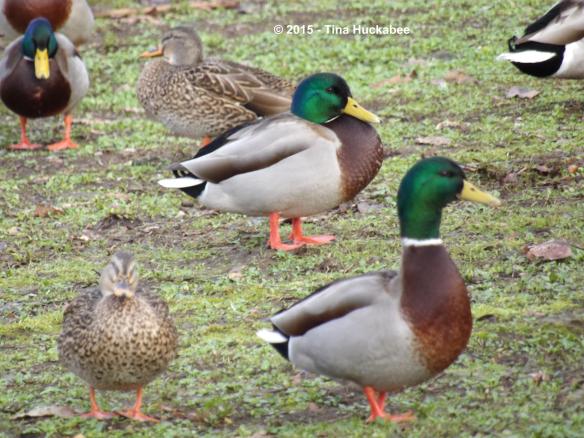 I guess the obvious thing to say here is: Go Ducks!!
I guess the obvious thing to say here is: Go Ducks!!
My garden enjoyed wild visitors this past month and I’m sure yours did too. Please join in posting about the wildlife in your gardens for February Wildlife Wednesday. Share the rare or mundane, funny or fascinating, beneficial or harmful critters you encounter. When you comment on my post, please remember to leave a link to your Wildlife Wednesday post so we can enjoy a variety of garden wildlife observations.
Good wildlife gardening!


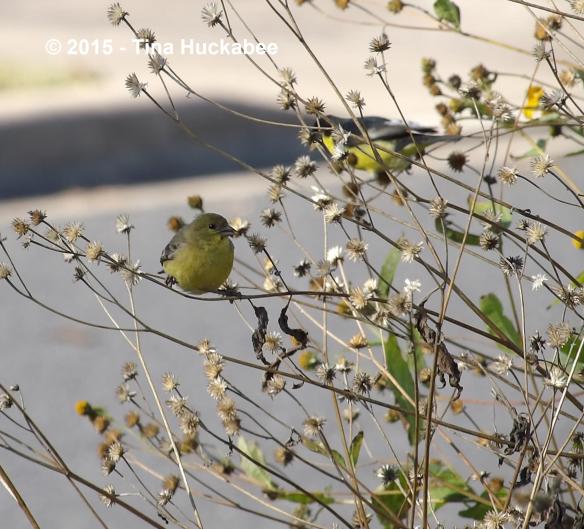



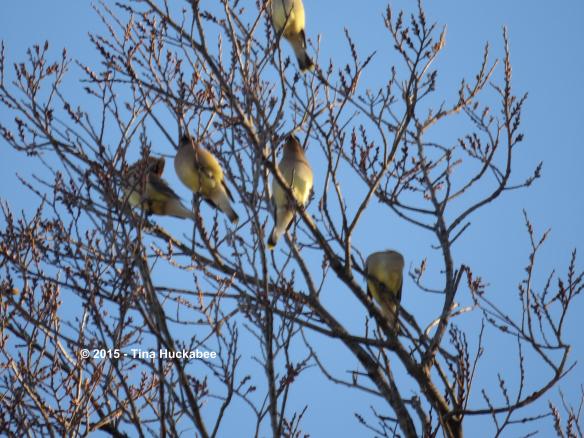



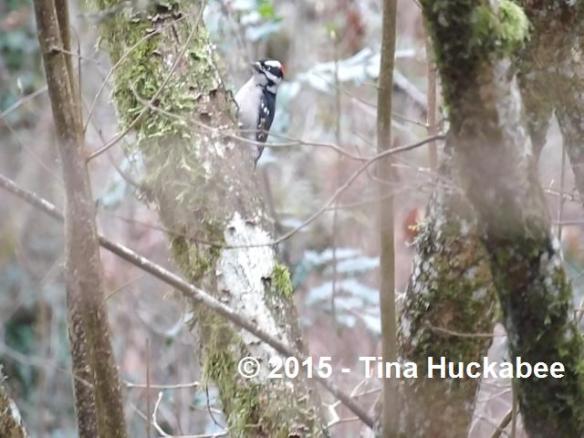
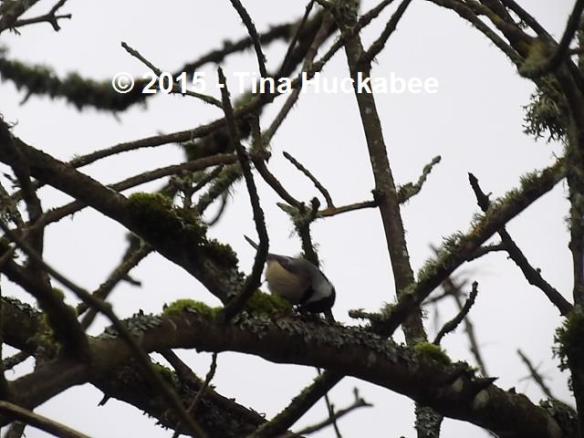
Pingback: Wildlife Wednesday – Looking back at January Garden Visitors | Gardening Jules
So many great photos – your goal is being realized – I hope you are pleased? And, thanks for taking us along with you to Oregon (go Ducks!). I wouldn’t worry about those great blue herons – everybody knows they wake up angry and their attitude just gets worse from there. (not really, but they always LOOK so durned irritated and annoyed).
I am featuring some pretty usual suspects this month. My February post is here:
http://austinagrodolce.blogspot.com/2015/02/february-wildlife-wednesday.html
I haven’t seen many birds around recently though I hear them all the time. Nearby construction, a feature that has been constant for the past few years, keeps disrupting nesting sites and it seems all the locals are rearranging as a result. My wildlife visitors and residents seem as variable as the weather lately.
LikeLike
I’m generally pleased with the photos–still a decent learning curve, though.
It was a good trip to Oregon–I’d hoped for yuckier weather, to dampen my ardor for the place, but really, it was quite nice. Eugene’s a pretty place–mostly we’d been there only to visit campus, move him in/move him out–this trip was reasearch. 🙂
Yeah, those herons look cranky. I love the expression on that second one–that’s a photo I’m happy about. I was pretty far away too.
It’s too bad your birds are being displaced–ugh. I hear birds too, like the Cedar Waxwings and woodpeckers, more than I see them. Your post was great and so glad you shared!!
LikeLike
Wonderful post Tina, I understand there are occasional sightings over here of Cedar Waxwings coming in from Northern Europe but I have never seen one, what a beautiful bird that is. We do not have the Chickadee or your American Robin, our Robins are smaller and feisty, although in our garden we have a pair of European Robins currently, I am really hoping for a nest. What a beautiful bird Coopers Hawk is too, we do not have the variety of raptors that you have in America.
Thanks for hosting this Tina, I’ve really enjoyed putting a blog together for your meme and hope to contribute regularly.
LikeLike
Thank you, Julie and thanks for joining in today!
I wonder, is the Cedar Waxwing the same species as ours? Hmm, I’ll have to look that up. They are truly beautiful–their markings and the brilliance of the colors–wow. I thought, from photos that I’d seen of your robins, that they might be larger. Ours are fairly good sized. We used to see them here in Austin, regularly about this time of year, but it’s been about a decade since I’ve seen one in my gardens (sniff), so I’m glad to see them in Oregon.
I love raptors and that Cooper’s was a real treat.
Your post was great and I hope too that you continue to participate!! Thanks for joining in.
LikeLike
Your garden provides lots of interest for wildlife including that hawk who finds it a pretty good hunting ground. All in the cycle of life but please don’t send him over here! The birds are really getting busy and cardinals with their cheerful call remind us spring is around the corner. I have been watching the wrens foraging late in the day. Better be getting those extra birdhouses up so that they have plenty to work on. Happy Wildlife Wednesday.
LikeLike
Yeah, I’ll do my best to keep our raptors here. I imagine you have your share where your are.
You’re right about the uptick in action and activity by the birds–wrens, cardinals and the like–they’re getting busier and more noticeable.
Good wildlife gardening to you, too, Jenny!
LikeLike
Such wonderful visitors. The titmouse(s) you’ve been posting pictures of are all beautiful, no matter which type they might be! I wish we had them here. I see we’ve both been visited by some form of goldfinch. They’re so pretty and seem somewhat less afraid of humans wandering about than some other birds. I was outside taking some photos of them and they never moved from the feeders. Your photos from your trip are great, also. I’ve noticed that we have more robins here than usual. A sign that spring is just around the corner perhaps?! Wonderful post. Here’s the link to mine:
Thanks so much for hosting!
LikeLike
Pingback: Wildlife Wednesday: February 2015 | Under the Pecan Leaves
Lovely images in your post today. I don’t have a post this month but I’ll try for next month. But I did see an amazing thing today – a slug absailing down from the roof of the greenhouse to reach more tasty seedlings, I’ve heard of this but never seen it before.
LikeLiked by 1 person
How absolutely cool! That would have been a remarkable set of photos! I hope you can join in next month, Christina.
LikeLiked by 1 person
Great photos and so nice to see the Willamette project. I also think that a titmouse by any name is just as cute. And thanks for the lead on the holly. I have a deciduous holly growing here covered in berries but I wasn’t sure what kind it was.
I only have one bird to show but I -nearly- got a photo of a house finch. haha
https://mylandrestorationproject.wordpress.com/2015/02/04/wildlife-wednesday-february-2015-2/
LikeLike
I agree about the titmouse–it doesn’t matter which one, they’re just the cutest. I love Possumhaw–I’ll be posting about it next week–stay tuned!
And what a bird it is on your post. I know what you mean about the house finch photos, or not: they’re always in my feeders and trees and I’ve yet to get a photo.
Thanks for participating in Wildlife Wednesday!
LikeLike
Quite a flock of birds you collected for your post. The Cedar Waxwings are so special and encouraging to see since we haven’t spotted any for several years. Maybe they will return this year.
http://rockoakdeer.blogspot.com/2015/02/wildlife-wednesday-february-2015-hawk.html
LikeLike
I think January and February are such good months for easy birdwatching. The Cedar Waxwings are so, so beautiful. My goal for these next few weeks is to get a good photo of one. Wish me luck with that. I hope you do get them–they’re a treat, even if they fly too fast.
Thanks for participating, Shirley!
LikeLike
Tina I agree the birds are the star right now although we are seeing deer and our fox too…I’ll link in tomorrow.
LikeLike
Aren’t you lucky to have a visiting fox. I’m looking forward to your post, Donna.
LikeLike
Here’s the post…hope you enjoy it…
http://www.livingfromhappiness.com/wildlife-lessons-the-gentleness-of-deer/
LikeLike
Great photos of the U of Oregon birds and the birds in your backyard. Gosh, I wouldn’t have known the difference with the Titmouse. Apparently the Tufted is the only Titmouse species we have here in Wisconsin, and mainly in the south of the state in spring and summer. We’ve had them here in our garden most summers. I love their cheery Peter-Peter-Peter-Peter song. 🙂
LikeLike
Thanks, Beth. I just always assumed that the titmouse that’s most common here is the Tufted and it’s the Black-crested. Well, that’s a major reason why I’m doing Wildlife Wednesday–to improve my knowledge of the wildlife in my gardens and appreciate wildlife in other gardens. You’re right, the titmouse does have a charming little call!
LikeLike
Hi Tina – the Cooper Hawks are really making their rounds right now – you have them, I have them, and I’ve seen several other gardeners showcases the hawks in their gardens this month. I guess as the small birds become more reliant on the seeds provided by our gardens and feeders at this time of year, the hawks flock to where their prey feasts. I am so jealous of your cedar waxwings. I think they are my favorite looking bird. I spotted them in my yard this time last year, but haven’t seen them yet this year. Here is the wildlife in my garden this month. http://rebeccastexasgarden.blogspot.com/2015/02/wildlife-wednesday-february-2015.html
Thanks!
LikeLike
Thank you, Rebecca! I think you’re right about the Cooper’s–they have lots to hunt because of the attraction of smaller birds to urban areas.
I have Cedar Waxwings come through every winter/spring. They’re so beautiful, I just wished they’d stop and pose for me.
LikeLike
How about that – just as soon as I complain – waxwings make their way to my yard! (I wish that was the case with everything I complained about 😉 I grab a couple snapshots to share next month!
LikeLike
Sometimes, complaining does get you somewhere, though I don’t think the Cedar Waxwings heard you on this one. Great–they’re so pretty. I’ve heard them in the last few days (that high-pitched, sort-of squeak in the background) and have seen them fly, but they haven’t landed, or a least, not when I’m looking.
LikeLike
A lovely post, I did enjoy it. I love looking at the wonderful birds you have there. The black crested titmouse is adorable.
The heron is a regular visitor to my pond but I never manage to get a photo. The slightest movement and he is off.
LikeLike
Thanks, Chloris. The titmouse is a darling little bird. I tend to have them and Carolina Chickadees (also ridiculously cute) at the same time in the gardens and at the feeders.
I was lucky with the heron shots, though several of them flew off; I also didn’t get as many egret shots as I wanted for the same reason.
Thanks for stopping by!
LikeLike
Wow…great post with all the birds… Michelle
LikeLike